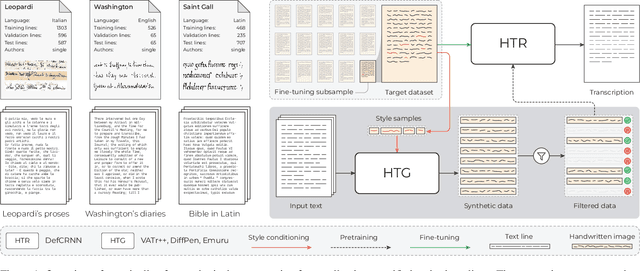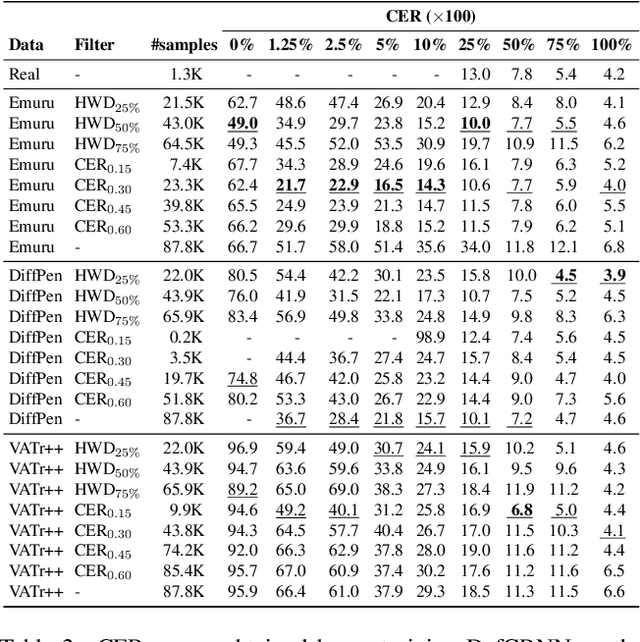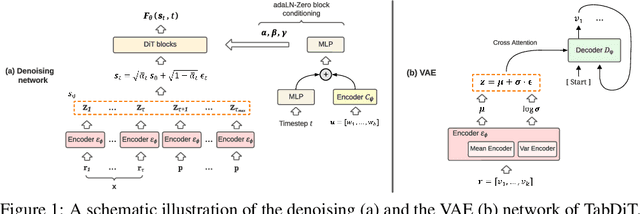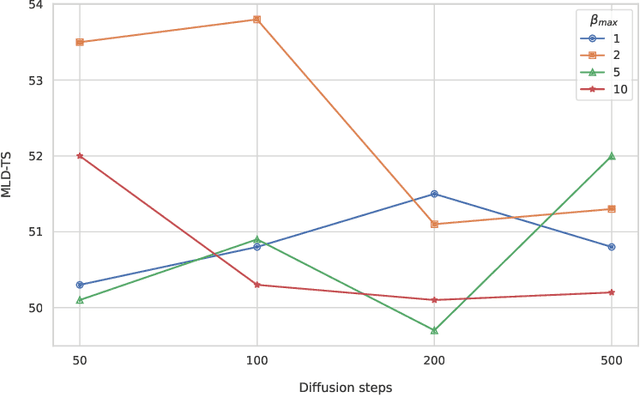Rita Cucchiara
Recurrence Meets Transformers for Universal Multimodal Retrieval
Sep 10, 2025Abstract:With the rapid advancement of multimodal retrieval and its application in LLMs and multimodal LLMs, increasingly complex retrieval tasks have emerged. Existing methods predominantly rely on task-specific fine-tuning of vision-language models and are limited to single-modality queries or documents. In this paper, we propose ReT-2, a unified retrieval model that supports multimodal queries, composed of both images and text, and searches across multimodal document collections where text and images coexist. ReT-2 leverages multi-layer representations and a recurrent Transformer architecture with LSTM-inspired gating mechanisms to dynamically integrate information across layers and modalities, capturing fine-grained visual and textual details. We evaluate ReT-2 on the challenging M2KR and M-BEIR benchmarks across different retrieval configurations. Results demonstrate that ReT-2 consistently achieves state-of-the-art performance across diverse settings, while offering faster inference and reduced memory usage compared to prior approaches. When integrated into retrieval-augmented generation pipelines, ReT-2 also improves downstream performance on Encyclopedic-VQA and InfoSeek datasets. Our source code and trained models are publicly available at: https://github.com/aimagelab/ReT-2
Dual Orthogonal Guidance for Robust Diffusion-based Handwritten Text Generation
Aug 23, 2025Abstract:Diffusion-based Handwritten Text Generation (HTG) approaches achieve impressive results on frequent, in-vocabulary words observed at training time and on regular styles. However, they are prone to memorizing training samples and often struggle with style variability and generation clarity. In particular, standard diffusion models tend to produce artifacts or distortions that negatively affect the readability of the generated text, especially when the style is hard to produce. To tackle these issues, we propose a novel sampling guidance strategy, Dual Orthogonal Guidance (DOG), that leverages an orthogonal projection of a negatively perturbed prompt onto the original positive prompt. This approach helps steer the generation away from artifacts while maintaining the intended content, and encourages more diverse, yet plausible, outputs. Unlike standard Classifier-Free Guidance (CFG), which relies on unconditional predictions and produces noise at high guidance scales, DOG introduces a more stable, disentangled direction in the latent space. To control the strength of the guidance across the denoising process, we apply a triangular schedule: weak at the start and end of denoising, when the process is most sensitive, and strongest in the middle steps. Experimental results on the state-of-the-art DiffusionPen and One-DM demonstrate that DOG improves both content clarity and style variability, even for out-of-vocabulary words and challenging writing styles.
Quo Vadis Handwritten Text Generation for Handwritten Text Recognition?
Aug 13, 2025



Abstract:The digitization of historical manuscripts presents significant challenges for Handwritten Text Recognition (HTR) systems, particularly when dealing with small, author-specific collections that diverge from the training data distributions. Handwritten Text Generation (HTG) techniques, which generate synthetic data tailored to specific handwriting styles, offer a promising solution to address these challenges. However, the effectiveness of various HTG models in enhancing HTR performance, especially in low-resource transcription settings, has not been thoroughly evaluated. In this work, we systematically compare three state-of-the-art styled HTG models (representing the generative adversarial, diffusion, and autoregressive paradigms for HTG) to assess their impact on HTR fine-tuning. We analyze how visual and linguistic characteristics of synthetic data influence fine-tuning outcomes and provide quantitative guidelines for selecting the most effective HTG model. The results of our analysis provide insights into the current capabilities of HTG methods and highlight key areas for further improvement in their application to low-resource HTR.
BRUM: Robust 3D Vehicle Reconstruction from 360 Sparse Images
Jul 16, 2025Abstract:Accurate 3D reconstruction of vehicles is vital for applications such as vehicle inspection, predictive maintenance, and urban planning. Existing methods like Neural Radiance Fields and Gaussian Splatting have shown impressive results but remain limited by their reliance on dense input views, which hinders real-world applicability. This paper addresses the challenge of reconstructing vehicles from sparse-view inputs, leveraging depth maps and a robust pose estimation architecture to synthesize novel views and augment training data. Specifically, we enhance Gaussian Splatting by integrating a selective photometric loss, applied only to high-confidence pixels, and replacing standard Structure-from-Motion pipelines with the DUSt3R architecture to improve camera pose estimation. Furthermore, we present a novel dataset featuring both synthetic and real-world public transportation vehicles, enabling extensive evaluation of our approach. Experimental results demonstrate state-of-the-art performance across multiple benchmarks, showcasing the method's ability to achieve high-quality reconstructions even under constrained input conditions.
RAID: A Dataset for Testing the Adversarial Robustness of AI-Generated Image Detectors
Jun 09, 2025Abstract:AI-generated images have reached a quality level at which humans are incapable of reliably distinguishing them from real images. To counteract the inherent risk of fraud and disinformation, the detection of AI-generated images is a pressing challenge and an active research topic. While many of the presented methods claim to achieve high detection accuracy, they are usually evaluated under idealized conditions. In particular, the adversarial robustness is often neglected, potentially due to a lack of awareness or the substantial effort required to conduct a comprehensive robustness analysis. In this work, we tackle this problem by providing a simpler means to assess the robustness of AI-generated image detectors. We present RAID (Robust evaluation of AI-generated image Detectors), a dataset of 72k diverse and highly transferable adversarial examples. The dataset is created by running attacks against an ensemble of seven state-of-the-art detectors and images generated by four different text-to-image models. Extensive experiments show that our methodology generates adversarial images that transfer with a high success rate to unseen detectors, which can be used to quickly provide an approximate yet still reliable estimate of a detector's adversarial robustness. Our findings indicate that current state-of-the-art AI-generated image detectors can be easily deceived by adversarial examples, highlighting the critical need for the development of more robust methods. We release our dataset at https://huggingface.co/datasets/aimagelab/RAID and evaluation code at https://github.com/pralab/RAID.
Inverse Virtual Try-On: Generating Multi-Category Product-Style Images from Clothed Individuals
May 27, 2025Abstract:While virtual try-on (VTON) systems aim to render a garment onto a target person image, this paper tackles the novel task of virtual try-off (VTOFF), which addresses the inverse problem: generating standardized product images of garments from real-world photos of clothed individuals. Unlike VTON, which must resolve diverse pose and style variations, VTOFF benefits from a consistent and well-defined output format -- typically a flat, lay-down-style representation of the garment -- making it a promising tool for data generation and dataset enhancement. However, existing VTOFF approaches face two major limitations: (i) difficulty in disentangling garment features from occlusions and complex poses, often leading to visual artifacts, and (ii) restricted applicability to single-category garments (e.g., upper-body clothes only), limiting generalization. To address these challenges, we present Text-Enhanced MUlti-category Virtual Try-Off (TEMU-VTOFF), a novel architecture featuring a dual DiT-based backbone with a modified multimodal attention mechanism for robust garment feature extraction. Our architecture is designed to receive garment information from multiple modalities like images, text, and masks to work in a multi-category setting. Finally, we propose an additional alignment module to further refine the generated visual details. Experiments on VITON-HD and Dress Code datasets show that TEMU-VTOFF sets a new state-of-the-art on the VTOFF task, significantly improving both visual quality and fidelity to the target garments.
What Changed? Detecting and Evaluating Instruction-Guided Image Edits with Multimodal Large Language Models
May 26, 2025Abstract:Instruction-based image editing models offer increased personalization opportunities in generative tasks. However, properly evaluating their results is challenging, and most of the existing metrics lag in terms of alignment with human judgment and explainability. To tackle these issues, we introduce DICE (DIfference Coherence Estimator), a model designed to detect localized differences between the original and the edited image and to assess their relevance to the given modification request. DICE consists of two key components: a difference detector and a coherence estimator, both built on an autoregressive Multimodal Large Language Model (MLLM) and trained using a strategy that leverages self-supervision, distillation from inpainting networks, and full supervision. Through extensive experiments, we evaluate each stage of our pipeline, comparing different MLLMs within the proposed framework. We demonstrate that DICE effectively identifies coherent edits, effectively evaluating images generated by different editing models with a strong correlation with human judgment. We publicly release our source code, models, and data.
Improving LLM First-Token Predictions in Multiple-Choice Question Answering via Prefilling Attack
May 21, 2025Abstract:Large Language Models (LLMs) are increasingly evaluated on multiple-choice question answering (MCQA) tasks using *first-token probability* (FTP), which selects the answer option whose initial token has the highest likelihood. While efficient, FTP can be fragile: models may assign high probability to unrelated tokens (*misalignment*) or use a valid token merely as part of a generic preamble rather than as a clear answer choice (*misinterpretation*), undermining the reliability of symbolic evaluation. We propose a simple solution: the *prefilling attack*, a structured natural-language prefix (e.g., "*The correct option is:*") prepended to the model output. Originally explored in AI safety, we repurpose prefilling to steer the model to respond with a clean, valid option, without modifying its parameters. Empirically, the FTP with prefilling strategy substantially improves accuracy, calibration, and output consistency across a broad set of LLMs and MCQA benchmarks. It outperforms standard FTP and often matches the performance of open-ended generation approaches that require full decoding and external classifiers, while being significantly more efficient. Our findings suggest that prefilling is a simple, robust, and low-cost method to enhance the reliability of FTP-based evaluation in multiple-choice settings.
Fashion-RAG: Multimodal Fashion Image Editing via Retrieval-Augmented Generation
Apr 18, 2025Abstract:In recent years, the fashion industry has increasingly adopted AI technologies to enhance customer experience, driven by the proliferation of e-commerce platforms and virtual applications. Among the various tasks, virtual try-on and multimodal fashion image editing -- which utilizes diverse input modalities such as text, garment sketches, and body poses -- have become a key area of research. Diffusion models have emerged as a leading approach for such generative tasks, offering superior image quality and diversity. However, most existing virtual try-on methods rely on having a specific garment input, which is often impractical in real-world scenarios where users may only provide textual specifications. To address this limitation, in this work we introduce Fashion Retrieval-Augmented Generation (Fashion-RAG), a novel method that enables the customization of fashion items based on user preferences provided in textual form. Our approach retrieves multiple garments that match the input specifications and generates a personalized image by incorporating attributes from the retrieved items. To achieve this, we employ textual inversion techniques, where retrieved garment images are projected into the textual embedding space of the Stable Diffusion text encoder, allowing seamless integration of retrieved elements into the generative process. Experimental results on the Dress Code dataset demonstrate that Fashion-RAG outperforms existing methods both qualitatively and quantitatively, effectively capturing fine-grained visual details from retrieved garments. To the best of our knowledge, this is the first work to introduce a retrieval-augmented generation approach specifically tailored for multimodal fashion image editing.
Diffusion Transformers for Tabular Data Time Series Generation
Apr 10, 2025



Abstract:Tabular data generation has recently attracted a growing interest due to its different application scenarios. However, generating time series of tabular data, where each element of the series depends on the others, remains a largely unexplored domain. This gap is probably due to the difficulty of jointly solving different problems, the main of which are the heterogeneity of tabular data (a problem common to non-time-dependent approaches) and the variable length of a time series. In this paper, we propose a Diffusion Transformers (DiTs) based approach for tabular data series generation. Inspired by the recent success of DiTs in image and video generation, we extend this framework to deal with heterogeneous data and variable-length sequences. Using extensive experiments on six datasets, we show that the proposed approach outperforms previous work by a large margin.
 Add to Chrome
Add to Chrome Add to Firefox
Add to Firefox Add to Edge
Add to Edge